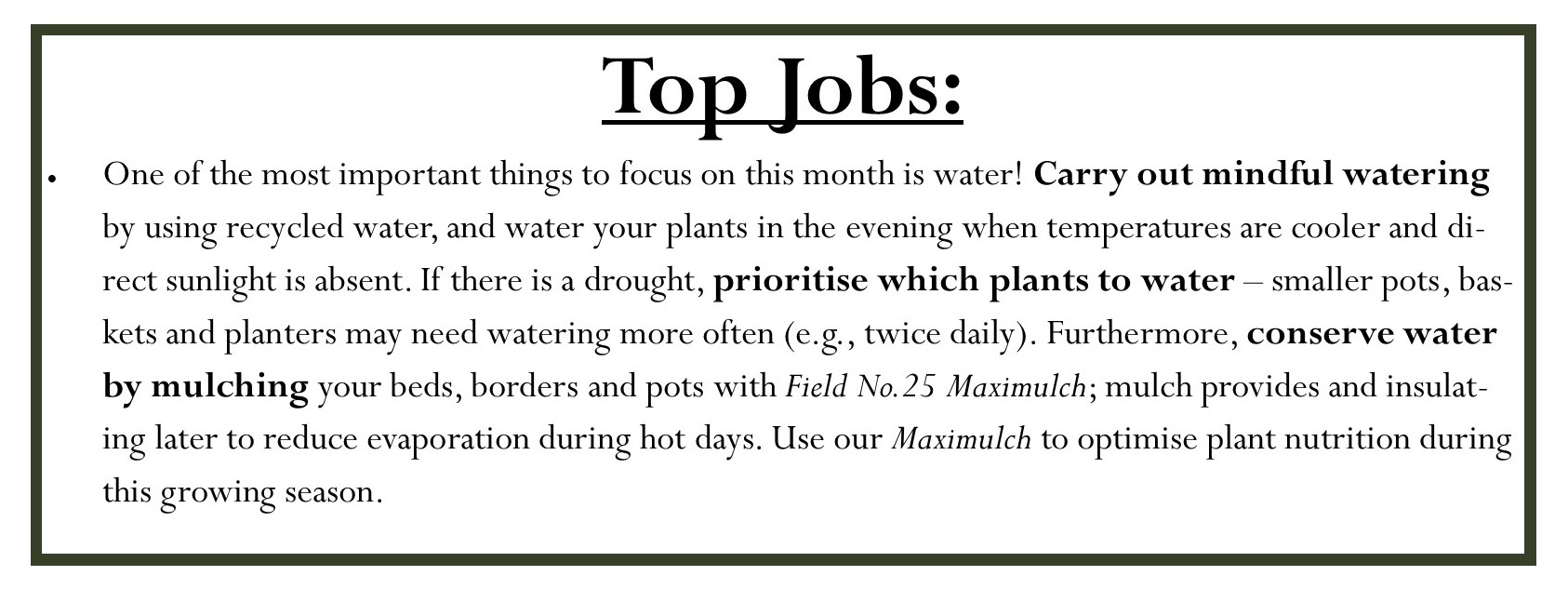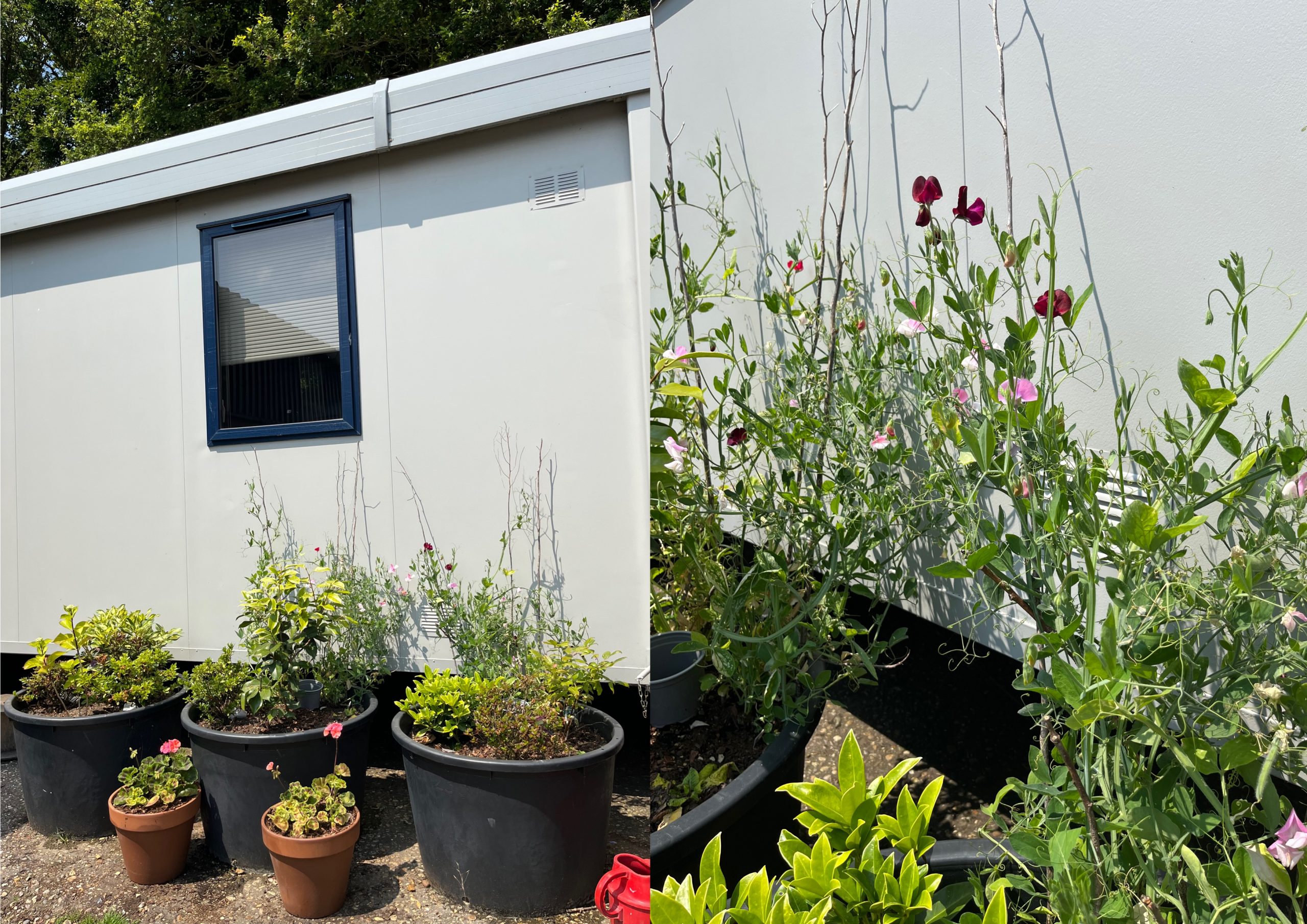Happy summer everyone! July is often one of the hottest months of the year (fingers crossed), and so it’s a great time to sit out and enjoy your garden – read below for some tips on how to make and keep your garden looking bright and beautiful!

General Maintenance:
- Take advantage of the dry weather to catch up on painting and preserving jobs; sheds, fences and garden furniture are regularly in need of a new coat.
- Top up bird baths, ponds and water features during hot weather.
Greenhouse:
- Damp down your greenhouse floor in the morning of hot days to increase humidity.
- Open greenhouse vents and doors on these warm days to improve air circulation.
- Debris can harbour pests and diseases, so regularly sweep greenhouse staging and floors.
Lawns:
Maintenance of established lawns:
- Mow and brush Field No.4 Organic Lawn Dressing into the sward to a depth of about 5mm.
- Raise the mower’s cutting height slightly, especially in hot weather. This can help the grass cope better when under stress in dry spells.
- Keep mowing pathways through areas of long grass to allow easy access around your garden.
- Resist the temptation to water established lawns, even in dry spells – the grass should cope well with drought, but if it dies back it will soon recover once the rain returns.
Maintenance of new lawns (less than a year old):
- Water areas that were newly sown or turfed in spring. Water every few days unless it rains, to keep these new lawns going through their first summer. Make sure to water regularly during spells of hot, dry weather, as young roots won’t be big enough to reach water stored deep in the ground.
- Cut new lawns every week or so – lower the height of blades progressively until they’re back to normal level. In hot weather keep the blades high or stop mowing for a while.

Flowers:
Jobs:
- Regularly deadhead plants to keep them looking good and to enjoy longer displays of blooms. Plants will look fresh and tidier, and it will also trick the plant into channelling its energy away from seed production and into forming additional flowers instead. Depending on the type of flower, use a sharp pair of secateurs or use your fingers to pinch out spent flower heads.
- Cut back delphiniums and geraniums after the first flush of flowers to encourage a second flowering period. Mulch with Field No.25 Maximulch after cutting them back to give them a feed of plant nutrition.
- Mulch borders with Field No.25 Maximulch; mulching can help to retain moisture and keep down the weeds, saving you a lot of work.
- Start collecting seeds from plants you want to grow next year, especially annuals like calendula, poppies and love-in-a-mist.
- Train and secure your climbers with plant ties as they will be fast growing and need support.
To plant:
- Autumn-flowering bulbs, e.g., autumn crocuses, Amaryllis and Nerine. Plant in pots and borders using Field No.23 Professional Potting Blend compost.
- Sow biennials for blooms next year. Use Field No.23 to form a seed bed:
- Foxgloves: sowing these in July will give them plenty of time to mature and flower the following summer.
- Honesty.
- Forget-me-nots: can be sown from May to September.
- Wallflowers: sow this summer to plant out in autumn. Use our Field.7 Seed Compost (not currently online) to sow the seeds in trays, then use Field No.23 when planting out.

Fruit & veg:
Jobs:
- Harvest your crops; harvest apricots, peaches, and nectarines, as well as runner beans, raspberries and strawberries. First early and second early potatoes should be ready to dig up this month (they do not store well, so enjoy them straight away). Harvest garlic and onions when their tops have gone yellow, and leave them to ripen in a dry, sunny spot.
- Check crops like runner beans regularly for aphids; rub or wash them off straight away so they don’t multiply.
- In hot weather, prioritise the watering of certain plants, e.g., crops growing in pots. Thirsty plants include celery, beans, peas, courgettes, pumpkins, tomatoes, cucumbers, and leafy crops like lettuce, rocket, coriander, and spinach.
- Cover brassicas with fine netting to prevent cabbage white butterflies laying their eggs on the leaves.
- Pinch out the side-shoots of cordon tomatoes to stop the stems growing any more and divert the plants energy into the swelling and ripening of the fruit.
To plant:
- Plant out young crops grown from seed in previous months. Plant out courgettes, squashes and sweetcorn early in the month to give them the best chance of cropping before the first of autumn frosts. Now is also the best time to plant out winter cabbages that were grown from seed in April and May, so that they’re mature in time for Christmas and beyond. Mix Field No.23 Professional Potting Blend compost with the soil in planting pit.
- Sow winter crops, e.g., potatoes, kale, winter cabbage and spinach to harvest during winter months and prepare for Christmas dinners. Use our Field No.23.
- Salad leaves, e.g., lettuce. These are quick and easy to grow, and by sowing the seed continuously (from May) until September, you can enjoy fresh salad as and when you like. Sow seeds in shallow drills or in pots filled with Field No.23.
- July is the last month to sow carrots for an autumn crop. So seeds direct and thinly into a seed bed made of Field No.23, or into pots of No.23.
- It is also the last month to sow dwarf French beans, to allow the pods time to mature before the first frosts of autumn.

Trees & shrubs:
Jobs:
- Tie in climbers and ramblers as they grow.
- Prune June-flowering shrubs, e.g., philadelphus and weigela after flowering. Also prune deciduous magnolias if necessary.
- Fast-growing hedges, like Leyland Cypress should be clipped as necessary throughout the growing season. Trim conifers and other garden hedges.
- Ensure newly planted trees and shrubs do not dry out – they often need much more water than people imagine.
- Water fruit trees and bushes, then lay some Field No.25 Maximulch around their base to hold in moisture.



